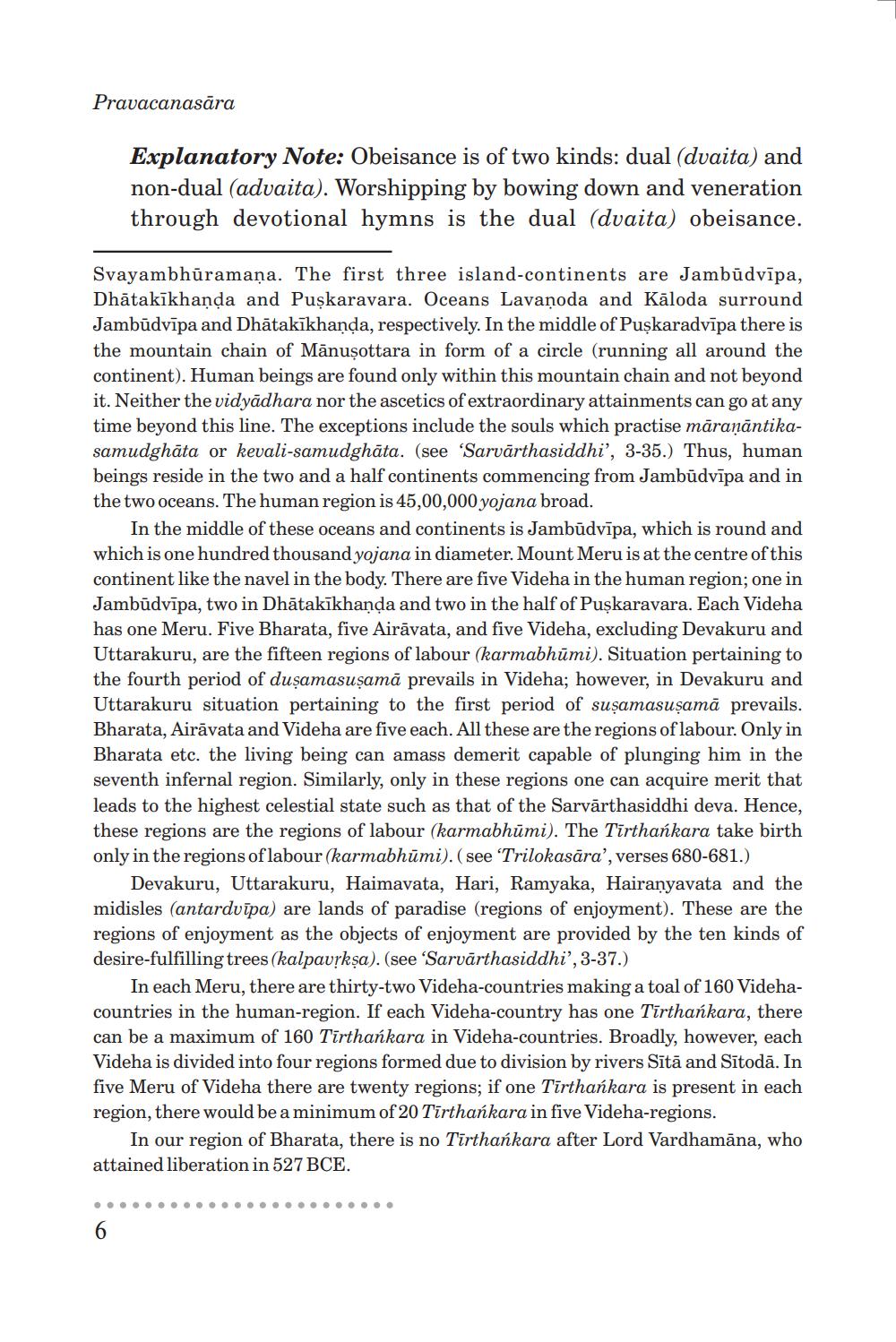________________
Pravacanasāra
Explanatory Note: Obeisance is of two kinds: dual (dvaita) and non-dual (advaita). Worshipping by bowing down and veneration through devotional hymns is the dual (dvaita) obeisance.
Svayambhūramana. The first three island-continents are Jambūdvīpa, Dhātakīkhanda and Puşkaravara. Oceans Lavanoda and Kāloda surround Jambūdvīpa and Dhātakīkhanda, respectively. In the middle of Puşkaradvīpa there is the mountain chain of Mānusottara in form of a circle (running all around the continent). Human beings are found only within this mountain chain and not beyond it. Neither the vidyādhara nor the ascetics of extraordinary attainments can go at any time beyond this line. The exceptions include the souls which practise māraṇāntikasamudghāta or kevali-samudghāta. (see 'Sarvārthasiddhi', 3-35.) Thus, human beings reside in the two and a half continents commencing from Jambūdvīpa and in the two oceans. The human region is 45,00,000 yojana broad.
In the middle of these oceans and continents is Jambūdvīpa, which is round and which is one hundred thousand yojana in diameter. Mount Meru is at the centre of this continent like the navel in the body. There are five Videha in the human region; one in Jambūdvīpa, two in Dhātakīkhanda and two in the half of Puşkaravara. Each Videha has one Meru. Five Bharata, five Airāvata, and five Videha, excluding Devakuru and Uttarakuru, are the fifteen regions of labour (karmabhūmi). Situation pertaining to the fourth period of duşamasuşamā prevails in Videha; however, in Devakuru and Uttarakuru situation pertaining to the first period of susamasuşamā prevails. Bharata, Airāvata and Videha are five each. All these are the regions of labour. Only in Bharata etc. the living being can amass demerit capable of plunging him in the seventh infernal region. Similarly, only in these regions one can acquire merit that leads to the highest celestial state such as that of the Sarvārthasiddhi deva. Hence, these regions are the regions of labour (karmabhūmi). The Tirthańkara take birth only in the regions of labour (karmabhūmi). (see Trilokasāra', verses 680-681.)
Devakuru, Uttarakuru, Haimavata, Hari, Ramyaka, Hairanyavata and the midisles (antarduīpa) are lands of paradise (regions of enjoyment). These are the regions of enjoyment as the objects of enjoyment are provided by the ten kinds of desire-fulfilling trees (kalpavrksa). (see 'Sarvārthasiddhi', 3-37.)
In each Meru, there are thirty-two Videha-countries making a toal of 160 Videhacountries in the human-region. If each Videha-country has one Tīrthankara, there can be a maximum of 160 Tīrthankara in Videha-countries. Broadly, however, each Videha is divided into four regions formed due to division by rivers Sītā and Sītodā. In five Meru of Videha there are twenty regions; if one Tīrthańkara is present in each region, there would be a minimum of 20 Tīrthańkara in five Videha-regions.
In our region of Bharata, there is no Tīrthańkara after Lord Vardhamana, who attained liberation in 527 BCE.




